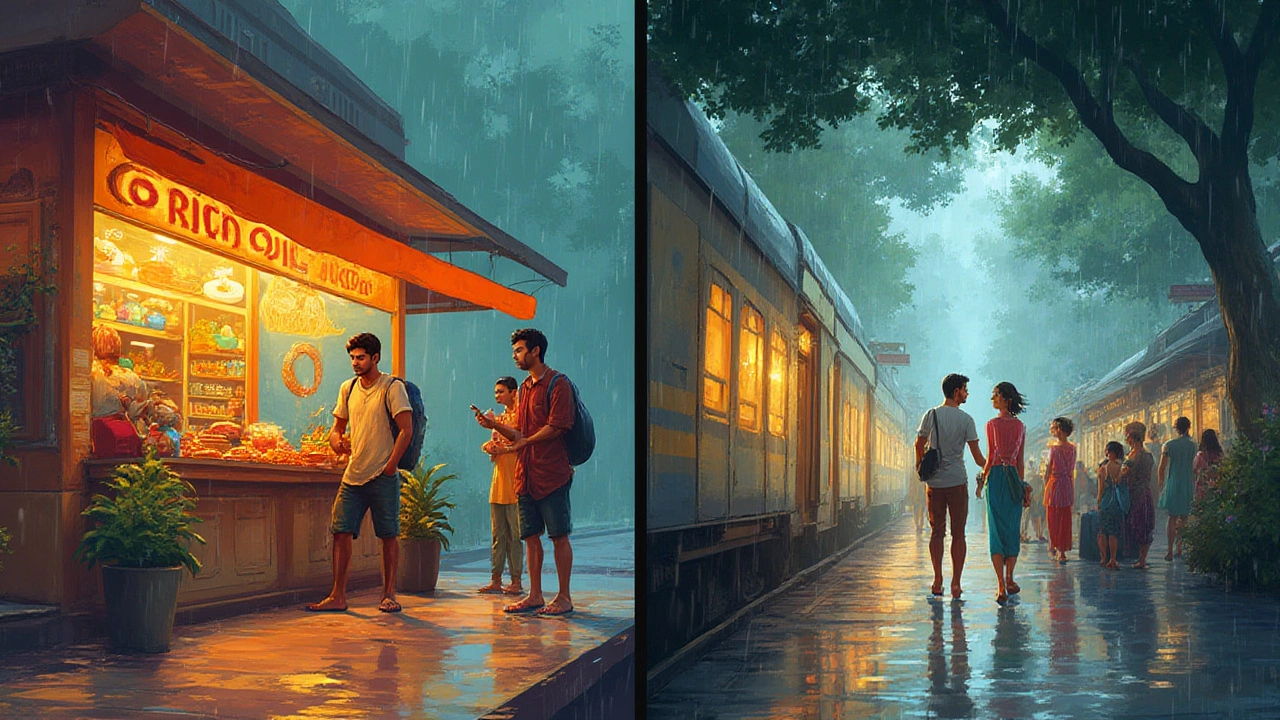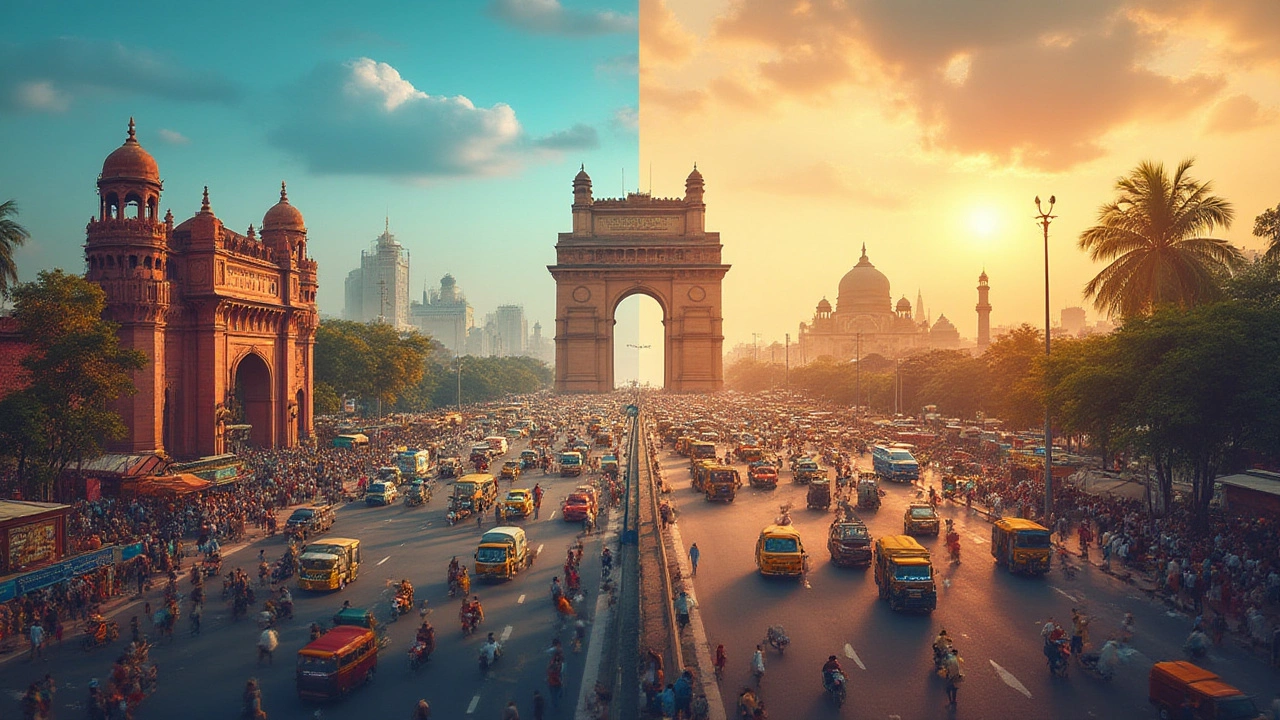Picture this: India’s two mega-cities are locked in the kind of rivalry that sparks heated debates everywhere from chai stalls to fancy rooftop bars. Ask anyone in the country which city is better—New Delhi or Mumbai—and you’ll open a Pandora’s box. Some will swear by Delhi’s historic charm and lush boulevards. Others can’t give up the energy and drive-the-coast feeling of Mumbai life. The real question, though, isn’t about loyalty. It’s about which city fits you, your vibe, and your plans. If you want the truth about how these powerhouses stack up for both travel and daily life, keep reading. It might just surprise you.
Urban Heartbeats: The Daily Rhythm of Delhi & Mumbai
Let’s not beat around the bush: New Delhi and Mumbai feel worlds apart, even though they’re only about two hours apart by plane. Delhi, the capital, has a regal, spacious vibe—broad tree-lined avenues, sprawling parks, and aristocratic remnants from the Mughal Empire and British Raj. Ever wandered beneath the towering domes of Humayun’s Tomb or lost yourself in the tangled bazaars of Old Delhi? City life here mixes slow, aromatic mornings with sudden bursts of chaos at Connaught Place. You’ll see yoga at Lodhi Garden before breakfast, and traffic jams where cows, honking cabs, and tuk-tuks battle for supremacy by lunch.
Meanwhile, Mumbai is gritty, humid, and urban to the core, stretching along the Arabian Sea with barely enough space for its relentless urge to grow. The city pulses 24/7. It's impossible not to notice: film stars in Bandra, chai vendors dodging puddles in Colaba, local trains packed with a sea of humanity. Even the rain has attitude here—monsoon floods can turn every commute into an adventure. Morning starts with vada pav and strong filter coffee, ends at Marine Drive staring at the city lights bouncing off the water. Think Bollywood dreams, business hustles, and late-nighters stumbling into 3 am street food.
If you crave green, quiet corners and a slower stride between stunning ruins and modern government buildings, Delhi feels right. But if you live for crowds, never-ending street chatter, and a sense that anything could happen if you just keep moving, Mumbai grabs you and doesn’t let go.
Tip for travelers: Street food culture is essential in both cities, but if hygiene spooks you, Delhi’s fancier Khan Market or Mumbai’s sanitized food courts are safer bets than random stalls.
Weather Wars, Money Matters, and Getting Around
Here’s a fact that might shock you: Delhi’s summers regularly shoot past 45°C (113°F), with dry, scorching heat that saps your will to move. Winters swing to the other extreme, turning the city misty, chilly, and sometimes smog-choked from November to January. Pack layers and a mask, especially if you have allergies. Mumbai plays a different weather game—temperatures rarely stray out of the 25°C–35°C (77°F–95°F) zone, but the humidity sticks to you year-round. Monsoon season (June to September) brings scenes you just have to see: flooded streets, delighted kids splashing everywhere, and a city that miraculously never stops running.
Living costs flip according to priorities. According to a 2025 Numbeo survey, Mumbai’s average apartment rent is 32% higher than in Delhi. Eating out is pricier in Mumbai, thanks both to costlier real estate and the city’s endless appetite for trends. On the flip side, Delhi’s cheaper rents can disappear fast in posher South Delhi neighborhoods or gated communities in Gurgaon, just next door.
Getting around is a love-hate relationship in both places. Delhi Metro is spotlessly clean, reliable, and cheap—arguably India’s best mass transit, covering long distances with air-conditioned comfort for as little as ₹10–₹60 a ride. Add Uber and autorickshaws, and you’ll survive—even in traffic snarls. Mumbai’s BEST buses and local trains are life itself for tens of millions, legendary for both their efficiency and their crush-hour discomfort. Rides can be a wild, sweaty adventure, but there’s nothing quite like the Mumbai local vibe when office-goers swap homemade lunchboxes and share life stories between stops.
Tip for new residents: In Delhi, nail your metro card and Ola app. In Mumbai, learn the train schedule—and try to avoid rush hour at Dadar station unless you love real-life crowd surfing.

Culture Clash: Food, Festivals, and Daily Attitude
Cuisine in Delhi is a spicy parade of North Indian classics: creamy butter chicken, sizzling kebabs, paratha breakfasts, and endless versions of chaat. Old Delhi’s Chandni Chowk could keep a foodie happy for years. Just beware: spices sneak up on you after the third bite. Mumbai swings to a different heat—seafood, spicy vada pav, frankies, and Irani cafés with antique marble tables and stories in every corner. This is the only city where bhel puri tastes best on a rainy day by the sea.
Festivals bring both cities to a boil, but with different flavors. Delhi explodes during Diwali—the Festival of Lights—with cracker booms echoing against imperial facades. Holi in Delhi is famously wild, with colored powder flying everywhere, while Republic Day parades line up tanks and dancers along Rajpath. Mumbai puts on its flashiest show for Ganesh Chaturthi, with processions and giant idols parading toward Chowpatty Beach, plus Christmas lights that feel right at home in Bandra.
Attitude is just as important as the calendar. Delhiites are famously direct—sometimes nosey—quick to strike up spirited conversations, cut deals, or invite you to a family wedding if you so much as mention you like jalebi. Mumbai locals pride themselves on tolerance, being a city that never says no—whether you’re a Bollywood hopeful or a billionaire. Everyone, rich or poor, shares the same pavements, and pitching into community efforts during monsoon or festival time is just how things work.
Here’s something most guidebooks miss: Delhi’s slower pace means weekends are all about lazy brunches and historic strolls. Mumbai, with its relentless speed, means you’re never far from a gig, film shoot, or cricket match. If you live for theater and new restaurants, Mumbai wins; if you want poetry nights or academia, Delhi delivers.
Which City Wins: Data, Deals, and the Real-Life Verdict
| Feature | New Delhi | Mumbai |
|---|---|---|
| Population (2023, est.) | 32 million | 21 million |
| Avg. 1-Bedroom Rent (City Center, USD) | ~$315 | ~$415 |
| Public Transit Pass (Monthly, USD) | $13 | $10 |
| Sunny Days (Annual avg.) | 255 | 320 |
| Best Time to Visit | Oct–Mar | Nov–Feb |
| Major Industries | Govt., IT, Education | Finance, Film, Shipping |
| Street Food Must-Try | Chole Bhature | Vada Pav |
So, is New Delhi or Mumbai “better?” That’s like asking if coffee is better than chai—it depends on your mood, your crew, and what drives you. If old forts, giant lakes, winter chills, and fiery curries mixed with ceremony are your thing, Delhi hands down. If you long for a city that refuses to sleep, where everyone’s hustling, the sea air kicks in at night, and each day brings wild surprises, make Mumbai your home base.
Still can’t pick? Try living a week in each. Catch Delhi’s morning fog, sample its endless fusion in cafes like Social or Indian Accent, breathe in its layers of culture with every turn. Then fly west and dive into Mumbai’s nightlife, hilltop hangouts, and seaside strolls—you’ll know soon enough which city calls your name. They’re both epic, but there’s always one that fits just right.
